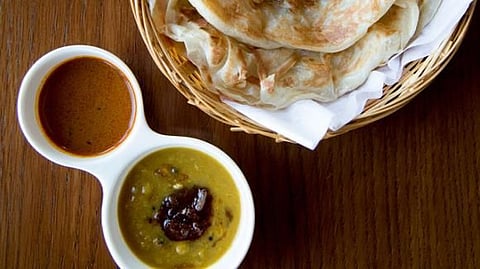A Malaysian Indian fish curry with mum’s seal of flavour
When India’s Tamil Muslims migrated to Malaysia, they created Mamak

You know that moment when you taste something and a light instantly flashes on in your mental library of memories?
All it took was a curry in a shallow dipping bowl for multiple bulbs to flicker disjointedly in my mind. I groped around the dusty corner of my mind called ‘Childhood’ and tracked down the section on Mum’s Cooking – there was an overriding flavour in the curry that I had tasted in my mother’s kitchen. But the asynchronous flickering simply didn’t shed enough light for me to find the exact chapter across hefty volumes of childhood recollections.
When the server at Mamak Restaurant in Al Wasl Square had set the bowl down, he had given it a matter-of-fact introduction: ‘Fish curry’. Along with yellow dhal splashed with a fiery chilli sambal, it was the accompaniment for a tissue-thin, flaky roti smeared with egg and cheese. The curry was sour in the way that teases the lining of your mouth, making it leak until you plug it with another bite. The toasted fragrance of freshly ground spices sailed through the liquid, leaving behind a slight trail of residual heat. Maybe it shared something with my mother’s pickled eggplant curry?
Roti canai (pronounced roti chan-eye), is a popular dish of shallow-fried crepes and curry hawked across Mamak stalls in Malaysia. Mamak is a term associated with the Tamil Muslims from India who migrated to Malaysia and opened stalls that brought together the most comforting flavours of south Indian and Malaysian cooking. If there is a place to have tandoori chicken, fried Maggi noodles topped with eggs, chicken skewers dunked in sweet peanut satay sauce, fried rice snuggled into omelettes and towering ‘dosai’ sparkling with sugar and condensed milk, it would be at the Mamak stalls. Digesting it all would be almost impossible, if not for copious cups of teh tarik – chai that has been sloshed from tumbler to tumbler until it has a thick layer of froth on top.
I tore off another piece of roti, dipping it into the reddish, oily pool and raking my brains to decipher the ingredients. The roti itself required no detective work. I had attempted making it once for a particularly ambitious party menu after watching a YouTube video. The cook stretched a glistening ball of dough along the counter with his fingers and then tossed it dramatically until it had grown to become a taut, translucent sheet. He then folded it into a fragile parcel and slipped it over a griddle until it became flush with colour and crisp around the edges. For a week before my dinner party, I practiced with an imaginary roti in the air at work when no one was looking. It was almost the same – in both technique and intimidation – as a Kerala-style parotta. An hour before the party, I replayed my air technique with real dough and emerged triumphant from the kitchen with a stack of pathetically misshapen rotis that would have Mamak stalls up in arms across Malaysia. My dinner guests graciously maintained their silence.
The server had to be summoned back to the table. With every bite of the fish curry, I was only growing hungrier for the recipe. It was packed with concentrated flavour – fragrant, spicy, tangy all at once. A lone mustard seed bobbed into view, consoling me momentarily with the knowledge of at least one ingredient. Maybe it reminded me of mum’s green chilli gravy? The server frantically rushed to the chef with the hope of some answer to scratch my uncontrollable itch, but was dismissed with three words and nothing more: ‘Fish curry powder’. I was at my wits’ end.
Sometimes some flavours are so ingrained in your DNA that you take them for granted. This often happens to me with flavours that my mother brought to the table but that I never cared to watch being created in the kitchen. I am intimately familiar with the results of her magic through my childhood, but not with the tricks on how to get there. It took a trip to one of Mamak’s other branches, in Downtown Dubai and a manhunt for the owner to get the answer.
Muhammad Riaz, the owner of the family-run chain of Mamak restaurants in Abu Dhabi and Dubai, graciously shared the recipe for asam pedas with me. It was tamarind that balanced the spices in Mamak’s fish curry, the same way that vinegar balances out many a creamy French sauce.
Credit for the concentrated flavour of the dish does not solely go to tamarind – it is shared equally by the pounding of onions and shallots in a mortar and pestle, a drizzle of coconut milk and the fragrant combination of fenugreek, cumin, fennel, mustard seeds and curry leaves tempered in oil. My only gripe is that the fish used is kingfish, one that appears on the depressingly unsustainable list of fish in the country. Maybe I can coax Riaz to switch to pomfret, because that tiny dipping bowl of fish curry is worth lobbying for.
Now that fish curry has been correctly indexed in my mind for future reference, I feel liberated enough to appreciate other dishes on the menu. This time, I might keep things simple and order something my adult mind can instantly recognise, no matter how rusty and aged: Mamak-style Maggi noodles, and roti drizzled with sweet condensed milk.
Sign up for the Daily Briefing
Get the latest news and updates straight to your inbox




